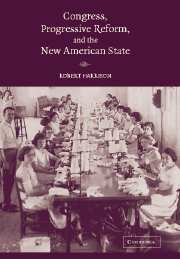Book contents
- Frontmatter
- Contents
- List of Tables
- Preface
- Acknowledgments
- Abbreviations
- Congress, Progressive Reform, and the New American State
- 1 Introduction
- 2 Congress and the Nation
- 3 The Troubled Subject of Railroad Regulation in the Progressive Era
- 4 Congress and the “Labor Question”
- 5 The Ideal of a “Model City”: Congress and the District of Columbia
- 6 The Senate and Progressive Reform
- 7 Patterns of Republican Insurgency in the House of Representatives
- 8 Progressivism, Democratic Style
- 9 Congress, Progressive Reform, and the New American State
- Appendix: The Analysis of Roll Calls
- Index
3 - The Troubled Subject of Railroad Regulation in the Progressive Era
Published online by Cambridge University Press: 25 July 2009
- Frontmatter
- Contents
- List of Tables
- Preface
- Acknowledgments
- Abbreviations
- Congress, Progressive Reform, and the New American State
- 1 Introduction
- 2 Congress and the Nation
- 3 The Troubled Subject of Railroad Regulation in the Progressive Era
- 4 Congress and the “Labor Question”
- 5 The Ideal of a “Model City”: Congress and the District of Columbia
- 6 The Senate and Progressive Reform
- 7 Patterns of Republican Insurgency in the House of Representatives
- 8 Progressivism, Democratic Style
- 9 Congress, Progressive Reform, and the New American State
- Appendix: The Analysis of Roll Calls
- Index
Summary
“The federal regulation of the railroads,” suggests Gabriel Kolko, was “the first example of national Progressivism, and possibly its most important single illustration.” Railroad companies, dependent for their very existence on privileges and sometimes subsidies conferred by government, had long been recognized as “affected with a public interest” and therefore liable to government supervision to a degree that other forms of business enterprise were not. For a generation state and federal governments had struggled with the economic and legal problems of railroad regulation. During the Progressive Era, in the shape of federal rate making by an independent commission, a solution was found that was wholly characteristic of government-business relations in the early twentieth century. The political struggles that brought it into being exemplify the processes that created the new American state.
Most early studies of railroad regulation identified advancement of the “public interest” as the primary, if not the sole, objective. The most obvious variety of “public interest” was that of consumers in low fares and freight rates, but the interest of the “people,” in relation to the railroads, was more commonly identified with that of their immediate customers, the farmers, merchants and manufacturers that shipped their goods by rail, who were characteristically depicted as small producers at the mercy of powerful corporations. The purpose of regulation was to protect the “unorganized” against the “organized.” Most recent scholarship gives pride of place to private, rather than public, interest in the politics of regulation.
- Type
- Chapter
- Information
- Congress, Progressive Reform, and the New American State , pp. 50 - 96Publisher: Cambridge University PressPrint publication year: 2004



